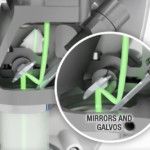What’s the engineering trick behind the Solea laser’s knack for precisely adapting to—and rapidly cutting—enamel, bone, dentin and soft tissue?
 WE ALL KNOW THAT inside our cars, there’s a spectacular confluence of mechanical and computer technology that makes them go. But unless you’re a gearhead, you probably just take it all for granted. The same is true for dental lasers. We all know what they do, but probably not exactly how.
WE ALL KNOW THAT inside our cars, there’s a spectacular confluence of mechanical and computer technology that makes them go. But unless you’re a gearhead, you probably just take it all for granted. The same is true for dental lasers. We all know what they do, but probably not exactly how.
 Early lasers were unable to match the speed of traditional drills, which meant patients weren’t guaranteed a reliably anesthesia-free experience. Modern lasers, of course, are much more advanced, perhaps none more than Convergent Dental’s Solea. It operates at a unique 9.3-micron wavelength and uses computer controls to precisely deliver energy for the treatment of both hard and soft tissue.
Early lasers were unable to match the speed of traditional drills, which meant patients weren’t guaranteed a reliably anesthesia-free experience. Modern lasers, of course, are much more advanced, perhaps none more than Convergent Dental’s Solea. It operates at a unique 9.3-micron wavelength and uses computer controls to precisely deliver energy for the treatment of both hard and soft tissue.
Solea’s powerful beam of light is actually optimized by a system called “galvos”: a series of microprocessor-controlled mirrors that move rapidly inside the arm of the laser. They’re capable of manipulating the beam thousands of times per second to create patterns expressly designed for the tissue being treated, whether it’s enamel, bone, dentin or soft tissue. Energy is distributed in patterns that vary in diameter, allowing doctors to choose the perfect size for the job at hand. Galvos facilitates speed, precision and control unprecedented in a dental laser, according to Convergent Dental.
That same technology is now enabling larger patterns for non-ablative therapies like Solea Sleep, a new treatment option for palatal snoring. A specialized pattern is deployed by doctors to deliver controlled, low-level energy targeting a specific area of tissue, reducing the risk of overtreatment.
Fun fact: Solea is currently the only dental laser using galvos to deliver fast cutting, at drill speed, with minimal patient discomfort. That means it’s likely more future-proof than average, as shown by its ability to go from powerful cutting to gentle snoring treatment.




